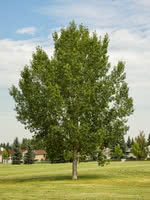Mon-Fri 9am - 5pm Mountain time
Northwest Poplar vs Wayfaring Tree
Populus x jackii Northwest
Viburnum lantana
CUSTOM GROW
Northwest Poplar is a large and fast-growing tree. Due to its wide spread, this tree makes a great shade or shelterbelt tree. Northwest Poplar tolerates partial shade, drought, and most types of soil. This poplar produces no fuzz.
Northwest Poplar continues to be popular as a shelterbelt species due to the great cost savings that come from the wide spread of the branches. It is a staff favorite because of the wonderful shade it provides all summer long.
Wayfaring Tree is an adaptable and reliable shrub. It is prized for its ornamental berries that can range in color from red to yellow to black. Consider getting two trees as fruiting is maximized when another Wayfaring Tree is present.
This species has a variety of uses ranging from naturalization, mass planting, borders, and privacy screens.
Northwest Poplar Quick Facts
Wayfaring Tree Quick Facts
In row spacing: 2.4 - 3 m (8 - 10 ft)

